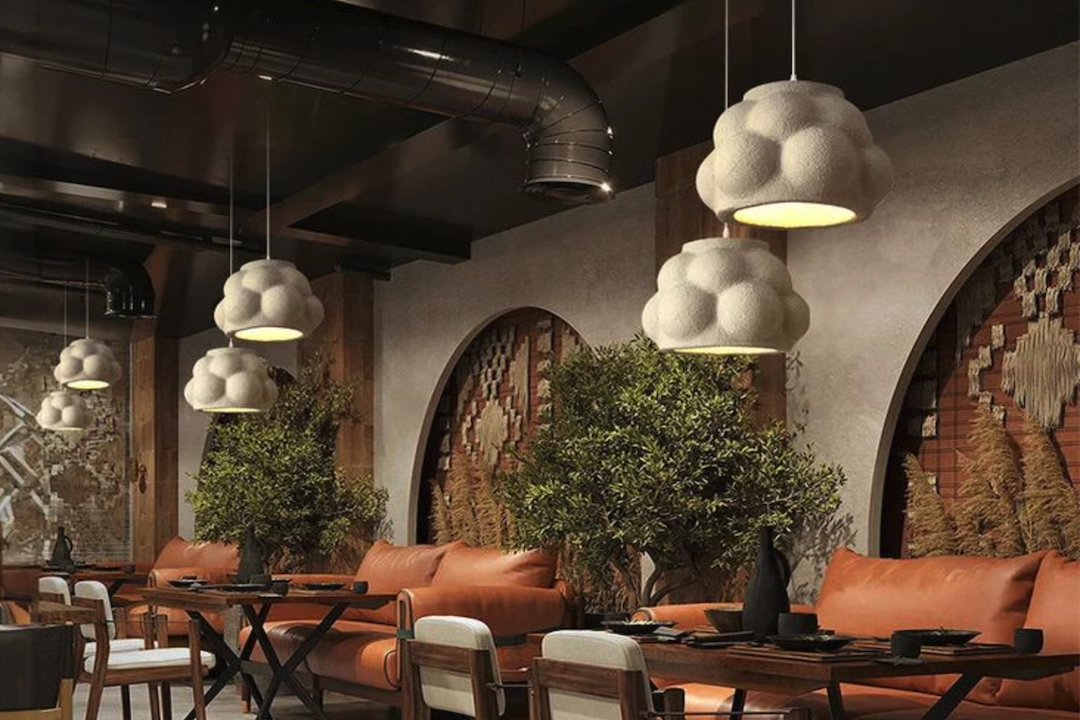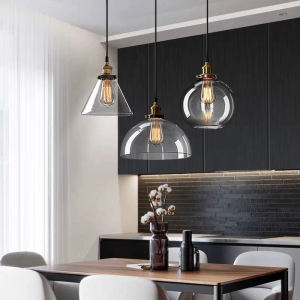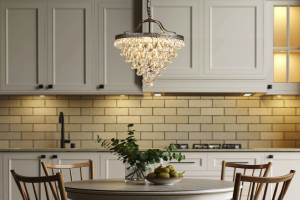
Enhance Ambiance with Stylish Restaurant Ceiling Lamps
The ambiance of a restaurant plays a pivotal role in shaping the overall dining experience. It encompasses various elements, including decor, music, and lighting, all of which contribute to the atmosphere that patrons encounter upon entering. A well-crafted ambiance can evoke emotions, influence customer behavior, and even affect the perception of food quality.
For instance, a cozy, dimly lit space may encourage diners to linger longer over their meals, while a bright, vibrant environment might promote a sense of energy and excitement. This emotional connection is crucial; studies have shown that diners are more likely to return to a restaurant where they felt comfortable and welcomed. Moreover, ambiance serves as a silent communicator of a restaurant’s identity and values.
It can convey themes ranging from rustic charm to modern elegance, helping to set expectations before the menu is even opened. For example, a fine dining establishment may opt for an upscale ambiance with plush seating and soft music, while a casual eatery might embrace a more laid-back vibe with colorful decor and upbeat tunes. The right ambiance not only attracts customers but also fosters loyalty, as patrons often associate their dining experiences with the feelings evoked by the environment.
The Role of Lighting in Creating Ambiance
The Power of Lighting in Setting the Mood
Different types of lighting can evoke distinct emotions and moods. Warm lighting, for instance, can create feelings of comfort and intimacy, while cooler lighting can impart a sense of modernity and cleanliness.
Highlighting Architectural Features and Functionality
The strategic use of lighting can draw attention to specific areas within the restaurant, such as architectural features or artwork, and enhance the overall aesthetic. Moreover, proper illumination is essential for diners to appreciate the presentation of their meals, which is critical in today’s visually-driven world.
Striking the Right Balance
A well-lit dish can enhance the colors and textures of the food, making it more appealing. On the other hand, poor lighting can obscure details and diminish the overall enjoyment of the meal. Therefore, finding the right balance between aesthetic appeal and functionality is vital for restaurant owners looking to create an inviting atmosphere.
Benefits of Stylish Ceiling Lamps
Stylish ceiling lamps Simiglighting serve as both functional lighting sources and decorative elements that enhance a restaurant’s ambiance. These fixtures can be focal points in a dining area, drawing the eye upward and adding character to the space. A well-chosen ceiling lamp can complement the overall design theme of the restaurant, whether it be industrial chic, vintage elegance, or minimalist modernity.
This dual purpose makes ceiling lamps an essential investment for restaurateurs aiming to create a cohesive look. Beyond aesthetics, stylish ceiling lamps also offer practical benefits. They can provide adequate illumination for dining areas without overwhelming patrons with harsh light.
Many modern ceiling lamps come equipped with adjustable brightness settings or dimmable features, allowing restaurant owners to tailor the lighting according to different times of day or specific events. This versatility ensures that the ambiance can shift seamlessly from lively brunches to intimate dinners, catering to various customer needs throughout the day.
Types of Restaurant Ceiling Lamps
There is a diverse array of ceiling lamp styles available for restaurants, each offering unique characteristics that can enhance different types of dining experiences. Pendant lights are particularly popular in casual dining settings; they hang from the ceiling and can be clustered together for dramatic effect or spaced out for a more understated look. These fixtures come in various shapes and materials, from sleek metal designs to colorful glass options, allowing for customization based on the restaurant’s theme.
Chandeliers are another option that can add an element of sophistication to fine dining establishments. These ornate fixtures often feature multiple bulbs and intricate designs, creating a sense of grandeur that elevates the dining experience. In contrast, flush mount lights are ideal for spaces with low ceilings or where unobtrusive lighting is desired.
They provide ample illumination while maintaining a clean and modern appearance. Additionally, track lighting offers flexibility; it allows restaurant owners to direct light where it is needed most, highlighting specific areas such as artwork or food displays.
Factors to Consider When Choosing Ceiling Lamps
When selecting ceiling lamps for a restaurant, several factors must be taken into account to ensure that they align with both functional needs and aesthetic goals. First and foremost is the size of the space; larger dining areas may require multiple fixtures or larger lamps to provide adequate illumination without feeling overcrowded. Conversely, smaller spaces may benefit from more compact designs that do not overwhelm the room.
Another critical consideration is the style and theme of the restaurant. The chosen ceiling lamps should harmonize with existing decor elements such as furniture, wall colors, and flooring materials. For instance, an upscale seafood restaurant might opt for elegant glass pendant lights that mimic the fluidity of water, while a rustic steakhouse could choose wrought iron fixtures that reflect its earthy charm.
Additionally, energy efficiency is an increasingly important factor; LED options not only reduce energy costs but also have longer lifespans compared to traditional bulbs.
Tips for Installing and Maintaining Ceiling Lamps
Proper installation and maintenance of ceiling lamps are essential for ensuring their longevity and effectiveness in creating ambiance. When installing ceiling lamps, it is crucial to consider the height at which they will be hung. For dining areas, pendant lights should typically be positioned at least 30 inches above tables to allow for comfortable conversation without obstructing views.
Additionally, ensuring that electrical connections are secure and compliant with local codes is vital for safety. Maintenance is equally important; regular cleaning can prevent dust buildup that may dim the light output or detract from the fixture’s appearance. Depending on the material of the lamp, different cleaning methods may be required—glass fixtures may need gentle polishing with glass cleaner, while metal surfaces might benefit from a soft cloth and mild detergent.
Furthermore, checking bulbs periodically for burnout and replacing them promptly will help maintain consistent lighting levels throughout the restaurant.
How Ceiling Lamps Can Reflect the Restaurant’s Brand
Ceiling lamps are not merely functional elements; they can also serve as powerful representations of a restaurant’s brand identity. The choice of lighting fixtures can communicate core values and themes that resonate with customers on a deeper level. For example, a farm-to-table restaurant might select rustic wooden pendant lights that evoke a sense of authenticity and connection to nature.
In contrast, a high-end sushi bar could opt for sleek, modern fixtures that reflect precision and elegance. Moreover, ceiling lamps can be used strategically to reinforce branding during special events or promotions. Seasonal decorations or themed lighting can create an immersive experience that aligns with marketing campaigns or holidays.
By thoughtfully integrating ceiling lamps into their branding strategy, restaurateurs can create memorable experiences that encourage customer loyalty and word-of-mouth referrals.
Examples of Successful Restaurant Ambiance with Stylish Ceiling Lamps
Numerous restaurants around the world have successfully utilized stylish ceiling lamps to enhance their ambiance and create memorable dining experiences. One notable example is “The Ivy” in London, renowned for its opulent decor featuring grand chandeliers that exude luxury and sophistication. The carefully curated lighting complements the restaurant’s upscale menu and attracts clientele seeking an elegant dining experience.
Another example is “Blue Hill at Stone Barns” in New York, which embraces a rustic yet refined aesthetic through its use of simple pendant lights made from natural materials. These fixtures reflect the restaurant’s commitment to sustainability and farm-fresh ingredients while providing warm illumination that enhances the overall dining atmosphere. In contrast, “Noma” in Copenhagen employs minimalist design principles with sleek ceiling lamps that focus on functionality while maintaining an artistic flair.
The understated lighting allows diners to concentrate on the culinary artistry presented on their plates without distraction. These examples illustrate how thoughtful selection and placement of ceiling lamps can significantly impact a restaurant’s ambiance, reinforcing its brand identity while enhancing customer experiences through carefully curated environments.


